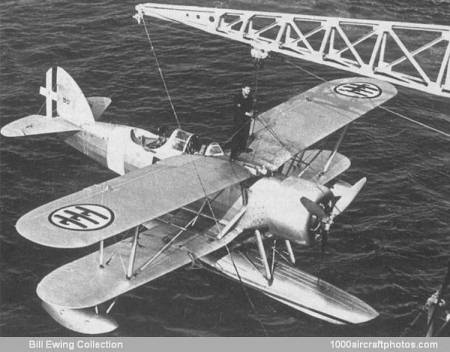The Ro.43 and 44 were unequal-span, folding-wing biplanes of mixed construction, the fuselages being welded steel-tube structures with light alloy and fabric skinning, and the wings having welded steel-tube spars and wooden ribs with fabric covering. The single-step central floats were of wooden construction and attached to the fuselages by short, wire-braced struts.
On November 1, 1939, the Ro.43 equipped twenty shipboard reconnaissance floatplane elements, 101 machines of this type being in service and a further twenty-nine being under construction. When Italy entered WW II, 105 were in service of which sixty-four were attached to Squadriglie of the Forze Navali, although only 42 of these were serviceable, eleven were stored at naval depots, and thirty were undergoing overhaul or repair. Many of the serviceable Ro.43s were aboard vessels of the Italian Navy, a Littorio class battleship sometimes carrying as many as three machines of this type for gunnery observation and reconnaissance.
Despite the fact that the Ro.43 possessed a low performance and poor "rough sea" characteristics, and was inadequately armed, it remained the standard shipboard type throughout the 39 months in which Italy fought as a partner in the Axis, and when the Armistice was signed on September 8, 1943, there were still twenty-eight Ro.43s aboard various warships, although only eighteen of these were serviceable, eleven were attached to the 2a Squadriglia Forze Navali, none of which were serviceable, and a further nine were attached to the 3a Squadriglia Forze Navali, only four of these being serviceable.
The last float fighter to serve with the Regia Aeronautica, the Ro.44 was a straightforward single-seat conversion of the Ro.43, the only changes being the deletion of the observer's cockpit and side windows and the replacement of the forward-firing 0.303 in (7.7 mm) Breda-SAFAT machine gun by twin 0.50 in (12.7 mm) Breda-SAFAT machine guns.
First flown in 1936, the Ro.44 equipped one Gruppo and one Squadriglia Caccia Marittima on November 1, 1939, but when Italy entered the war only the 161a Squadriglia Caccia Marittima based on the island of Lero in the Aegean was equipped entirely with the Ro.44, possessing eight of the remaining 25 machines of this type. The operational area of the unit was restricted to the Aegean, but by November 9, 1940, only four Ro.44s remained serviceable, and on June 11, 1941, the Squadriglia was disbanded, being reformed on C.R.42 Falcos. A few Ro.44s survived until the Armistice at which time three fighters of this type were attached to each of the 2a and 3a Squadriglia Forze Navali.
|
|
Ro.43 |
Ro.44 |
